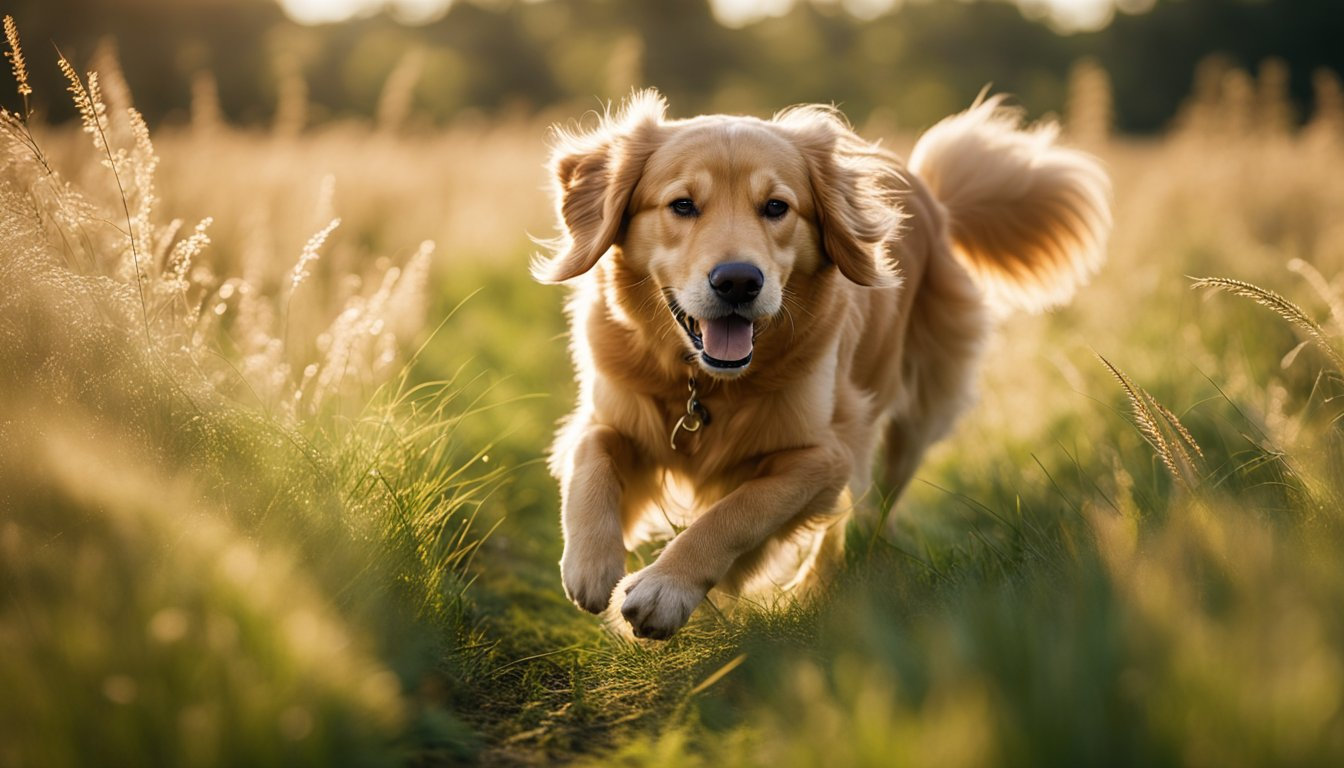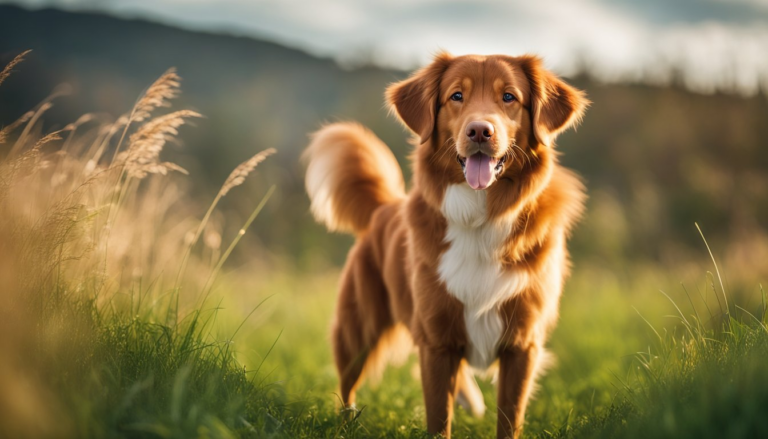Golden Retriever Breed Guide: Essential Tips for Owners
Golden Retrievers are a popular dog breed known for their friendly and affectionate nature. Originating from the Scottish Highlands in the mid-nineteenth century, they were bred for their abilities in hunting and retrieving game. Today, they are recognized by the American Kennel Club as a highly versatile breed that excels in various activities, such as companionship, assistance, and even search and rescue.
Their intelligence and eagerness to please make them ideal family pets and service animals. With their striking physical characteristics and amiable personality, it is no wonder that Golden Retrievers have captured hearts worldwide.
Key Takeaways
- This breed guide provides a thorough understanding of the Golden Retriever’s history and characteristics
- Golden Retrievers are known for their versatility, intelligence, and friendly nature, making them great companions and service animals
- Proper training, care, and grooming are factors for the well-being and success of these dogs in different living conditions and activities
Breed History and Origin
Development and Origins
The Golden Retriever originated in the highlands of Scotland during the late 19th century, where it was bred as a gun dog to retrieve shot waterfowl in difficult terrain and adverse weather conditions. The breed was developed through the careful crossing of different breeds by Lord Tweedmouth, a British aristocrat, at his estate in the Scottish highlands.
Among the breeds used in the development of the Golden Retriever are the now-extinct Tweed Water Spaniel, the Yellow Retriever, and the Irish Setter. These breeds were chosen for their excellent retrieving capabilities, trainability, and temperament, qualities that remain iconic for the Golden Retriever to this day.
| Breeds Involved | Characteristics Contributed | Purpose |
| Tweed Water Spaniel | Strong swimming ability, dense curly coat | Enhance water affinity |
| Yellow Retriever | Retrieving capabilities | Improve retrieving skills |
| Irish Setter | Intelligence, grace | Enhance temperament and intelligence |
Golden Retrievers are just one of the various types of retriever breeds that have been developed over the years. Some retriever breeds have an interesting history and it is fascinating to compare their development with that of the Golden Retriever, one example is the Labrador Retriever.
Original Purpose
The primary aim behind the breeding of Golden Retrievers was to create a reliable and skilled hunting companion. In the late 19th and early 20th century, British aristocrats and landowners participated in large shooting parties, where they required a dog breed capable of retrieving shot game, such as ducks and pheasants, from soggy marshes and dense forests. Golden Retrievers were specifically bred to withstand the harsh weather conditions of the Scottish highlands and to swim through the cold waters to bring back downed birds.
Over the years, the breed’s intelligence, trainability, and gentle temperament have expanded its original purpose beyond the hunting field. Golden Retrievers have become popular as assistance dogs, guide dogs, and search-and-rescue dogs. Their versatility and adaptability to various roles are testaments to their rich history and dedicated breeding process.
Physical Characteristics

Distinctive Features
Golden Retrievers have friendly eyes and expressive faces, which make them both attractive and easily approachable. Their heads are broad, with a well-defined stop and a straight muzzle that smoothly blends into a strong neck. The ears, moderately sized, are set approximately level with the eyes and hang close to the cheeks. The nose is usually black or brownish-black in color.
Size
| Gender | Weight Range (pounds) | Height Range (inches) |
| Male | 65-75 | 23-24 |
| Female | 55-65 | 21.5-22.5 |
Coat
The Golden Retriever’s coat is perhaps its most iconic feature. They have a lustrous, water-repellent double coat with a dense outer coat and a soft, insulating undercoat. The outer coat is medium length, either straight or wavy, and lies close to the body. The hair on the undercoat is short and dense. The golden color of the coat can range from light to dark, but it must be a rich, lustrous gold without any hint of red or mahogany tones.
Lifespan

These dogs have an average life expectancy of 10-12 years. Like all breeds, maintaining a healthy weight, providing consistent exercise, and staying up-to-date on veterinary care can positively impact their lifespan.
Grooming Needs and Frequency
Golden Retrievers have moderate grooming requirements. It’s essential to brush their coats at least twice a week to keep the fur healthy and minimize shedding. More frequent brushing, especially during shedding season, will help further prevent matting and tangles.
The undercoat should be checked regularly for any signs of skin irritation or infection. Ears must be cleaned regularly to prevent buildup and potential infections, while nails should be trimmed every 3 to 4 weeks to maintain a comfortable length.
By understanding and addressing the physical characteristics of Golden Retrievers, owners can provide the right care and environment, ensuring a happy and healthy life for these loving dogs.
Temperament and Personality
Behavior
Golden Retrievers are known for their friendly and outgoing personalities. They are gentle, social, and genuinely enjoy interacting with people, children, and other pets. Their warm and affectionate demeanor makes them great for families and as therapy dogs.
Golden Retrievers are also known for their loyalty and devotion to their owners and are always eager to please.
Trainability
Golden Retrievers are intelligent and easily trainable. Their intelligence and eagerness to please make them highly receptive to various training methods. In addition, their patience and forgiving nature ensure they are non-aggressive even during training mishaps.
Positive reinforcement, consistency, and patience are essential tools for training this breed. Engaging training techniques involving rewards, praise, and play keep them motivated and prevent boredom during the training process.
General Disposition
The general disposition of Golden Retrievers is what makes them so popular as family dogs. They are friendly, patient, and gentle with children, thriving in a home environment where they are involved in family activities. Their trusting nature and tolerance of other pets make them great companions even for multi-pet households.
When it comes to strangers, Golden Retrievers are typically friendly and welcoming, making them well-suited to social settings and not the best choice for guard dogs.
Golden Retrievers combine intelligence, friendliness, and a gentle temperament with a strong desire to please. Their loyal nature and aptitude for training make them an excellent choice for diverse roles such as guide dogs, search and rescue, and therapy dogs. By prioritizing proper training and socialization from a young age, Golden Retrievers will continue to exemplify these desirable characteristics throughout their lives.
Health and Wellness
Diet and Nutrition
Golden Retrievers require a balanced and nutritious diet to maintain their overall health. Being a large breed, they demand a proper intake of protein, whole grains, fruits, vegetables, and essential fatty acids. To prevent obesity, avoid excessive treats and monitor their daily caloric intake.
Portion control and meal timing are important in maintaining a healthy weight for this active breed. Ideally, they should be fed twice a day with consistently measured amounts.
Common Health Issues
Despite being a generally healthy breed, Golden Retrievers have certain genetic predispositions and health concerns. The most common health problems include hip dysplasia, elbow dysplasia, hypothyroidism, and various types of cancers. Heart issues, such as subvalvular aortic stenosis and dilated cardiomyopathy, can also occur.
Regular check-ups and maintaining a strong relationship with a veterinarian can help detect and manage these health issues.
Health Screenings

Always remember to conduct routine health screenings and tests for Golden Retrievers. To identify potential issues like hip and elbow dysplasia, veterinarians use radiographic examinations like X-rays. Checking for hypothyroidism involves blood tests and monitoring for signs of lethargy or weight gain.
Regular heart examinations can help detect any heart abnormalities, while comprehensive wellness examinations are beneficial for the early detection and management of cancers and other health concerns. It is also wise to consult a veterinarian for breed-specific screening recommendations.
Exercise Needs
Golden Retrievers are a highly energetic breed, requiring daily physical and mental stimulation. Ideally, they need at least an hour of exercise every day, which can include walking, running, swimming, or playing fetch. Participating in canine sports like agility, obedience, or dock diving can also keep them engaged and active.
Regular exercise helps in maintaining their muscle tone, managing weight, and reducing the risk of common health issues. Keep in mind the importance of monitoring the exercise intensity and avoiding overexertion, especially in puppies and senior dogs.
Training and Behavior
Behavioral Challenges
Golden Retrievers are known for their friendly, eager-to-please demeanor, which makes them easy to train. However, they can also present some behavioral challenges. These include potential issues with jumping on people, chewing, and digging.
Their high energy levels and enthusiasm can sometimes be overwhelming for owners, especially when they are young and not yet well-trained. To address these challenges, it is required to establish consistent house rules and boundaries. Reinforcing positive behavior through praise, treats, and playtime helps to create a strong bond between you and your Golden Retriever, encouraging them to continue displaying good behaviors.
Training Techniques
Training a Golden Retriever requires consistency, patience, and positive reinforcement. Here are some effective training techniques to help ensure success:
- Start with basic commands: Begin with fundamental commands such as “sit,” “stay,” “come,” and “heel.” Once your Golden Retriever masters these basics, you can introduce more advanced commands.
- Use positive reinforcement: Reward your dog immediately upon performing the desired behavior with a treat, praise, or playtime to reinforce the behavior.
- Keep training sessions short and enjoyable: Golden Retrievers are intelligent dogs that benefit from short, focused training sessions that maintain their interest.
- Incorporate mental stimulation: Ensuring your dog receives adequate mental stimulation through puzzle toys and interactive games can help reduce anxiety and prevent boredom, which may lead to destructive behavior.
Early Socialization

It is necessary to expose Golden Retriever puppies to various social situations from an early age, as this establishes a solid foundation for future training and behavior. The following methods can contribute to successful early socialization:
- Enroll in puppy classes: Puppy classes are a great way to introduce your Golden Retriever to other dogs and people, teaching them appropriate social behaviors.
- Expose to different environments: Safely exposing your Golden Retriever puppy to various surroundings, sounds, and people will help them develop confidence and adaptability.
- Engage in positive interactions: Encourage your Golden Retriever to interact with other dogs and people in a positive manner, reinforcing good behaviors during these interactions.
- Socialize consistently: Consistent socialization throughout your dog’s life will help maintain their social skills and prevent the development of fear or aggression-related issues.
By addressing behavioral challenges, employing effective training techniques, and prioritizing early socialization, you will set your Golden Retriever up for a successful, well-behaved life.
Working and Activities
Historical Role
Golden Retrievers were originally bred in the 19th century for hunting and retrieving waterfowl. They were highly valued for their abilities to work off-leash, locate game in difficult environments, and bring back the prey unharmed due to their soft mouths. This breed’s history in hunting and retrieving played a significant role in shaping their temperament and physical traits as highly trainable, intelligent, and energetic dogs.
Modern Roles
Today, Golden Retrievers excel in various roles beyond hunting. Their gentle nature and keen intelligence make them suitable for therapy and assistance work. They are commonly trained as guide dogs for the visually impaired, providing support and companionship to those who need them most.
Golden Retrievers are also highly skilled in search-and-rescue operations, using their exceptional scent detection abilities to locate missing persons or items.
Mental and Physical Stimulation
Golden Retrievers have a high energy level that requires frequent mental and physical stimulation. Proper exercise and engaging activities are essential to keeping them happy and healthy. Some activities they enjoy include:
- Fetch: This classic game allows them to engage their natural retrieving instincts and provides both mental and physical stimulation.
- Obedience training: Golden Retrievers are fast learners and enjoy the challenge of learning new commands and tricks.
- Agility courses: These activities not only provide an outlet for their energy, but also help to strengthen the bond between the dog and their owner.
- Swimming: This low-impact exercise is ideal for Golden Retrievers, as it allows them to engage in their natural love for water while burning off energy.
By providing adequate physical and mental stimulation, Golden Retrievers can maintain their well-being and happiness, ensuring they excel in their modern roles as beloved family pets, therapy dogs, or search-and-rescue specialists.
Care and Grooming

Golden Retrievers require regular care and grooming to keep their coat healthy and minimize shedding. Here are some key aspects to consider regarding their coat care, ear, teeth, and nail care, as well as shedding.
Coat Care
Golden Retrievers have a double coat, which consists of a thick undercoat and a water-repellent outer coat. Their coat requires regular brushing to prevent matting and distribute natural oils. It’s recommended to brush your Golden Retriever at least two or three times per week with a slicker brush and a comb. Keep the coat trimmed to avoid excess matting, especially around the ears, tail, and underbelly.
Ear, Teeth, and Nail Care
In addition to coat care, Golden Retrievers need regular ear, teeth, and nail maintenance. Check their ears weekly for any signs of infection or debris and clean them gently with a soft, damp cloth.
Dental care is essential for Golden Retrievers as they are prone to dental problems. Brush their teeth at least two or three times per week using a dog toothbrush and dog-specific toothpaste. This helps prevent tartar buildup and gum disease.
Trim your Golden Retriever’s nails every three to four weeks to prevent overgrowth and splitting. If you’re inexperienced in trimming dog nails, consult a professional groomer or your veterinarian for guidance.
Shedding
Shedding is a common characteristic of Golden Retrievers. Regular grooming and coat maintenance can help manage shedding and keep your home clean. Golden Retrievers typically shed seasonally, especially during spring and fall.
During these times, increase the frequency of brushing daily and use an undercoat rake or deshedding tool to remove loose hair effectively.
The care and grooming routine for Golden Retrievers is not only essential for their appearance but also ensures their overall health and well-being. Regular coat care, attention to their ears, teeth, and nails, and managing shedding properly will help maintain your Golden Retriever’s health and happiness.
Living Conditions
Housing
Golden Retrievers are adaptable dogs and can live comfortably in various types of homes. They can adjust well to both city apartments and large rural houses. However, it is necessary to provide them with a safe and secure environment, as well as ample space for play.
Since they are an active breed, Golden Retrievers thrive when they have access to open spaces where they can exercise and explore. Creating a dedicated area for your dog to play both indoors and outdoors will greatly benefit their overall well-being.
Outdoor Needs
Golden Retrievers have a strong need for physical activity and mental stimulation. They enjoy spending time outdoors, playing fetch, and engaging in other interactive games. Providing your Golden Retriever with a fenced yard, dog park visits, or regular walks will help them stay content and well-exercised.
It is needed to offer them opportunities to socialize with other dogs and people to ensure they develop into well-rounded and confident pets. Keep in mind that Golden Retrievers are also talented swimmers, so providing access to safe swimming areas can be a great source of exercise and enjoyment.
Climate Considerations
Golden Retrievers have a double coat that allows them to adapt to various weather conditions. Their thick undercoat keeps them warm in colder climates, while the water-repellent outer coat helps protect them from moisture. However, it is a good thing to monitor your dog during extreme weather conditions and provide shelter, shade, or cooling methods if necessary.
In hot climates, ensure that your dog has plenty of water and avoid walking them during the hottest part of the day. While they can tolerate cold weather reasonably well, it is still necessary to provide them with a warm and insulated space during the winter months. Regular grooming and brushing will also help maintain their coat’s health, enabling them to better adapt to temperature changes.
Adoption and Purchase
Considerations
Before getting a Golden Retriever, it is imperative to consider several factors. Golden Retrievers are intelligent, friendly, and energetic, requiring daily exercise and mental stimulation. They also need regular grooming due to their thick, double coat. Be prepared to dedicate time, effort, and resources to meet their needs to ensure a happy and healthy dog.
Reputable Breeders
If you decide to purchase a Golden Retriever from a breeder, it is required to recognize and choose a reputable one. A good breeder should prioritize the health and welfare of their dogs, conduct genetic testing to minimize health issues, and provide proper socialization and care for their puppies. They should also be knowledgeable about the breed and willing to answer any questions you may have.
One of the ways to find a reputable breeder is by checking the list of breeders from the Golden Retriever Club of America.
Rescue Organizations
Another option for adopting a Golden Retriever is through breed-specific rescue organizations. These organizations work to save and rehome Golden Retrievers who have been surrendered, abandoned, or are in need of a new home. They typically have adoption processes that include an application, interviews, and sometimes a home visit to ensure a suitable match between the dog and the prospective adopter.
By adopting from a rescue organization, you are not only providing a loving home to a dog in need, but also making room for other Golden Retrievers who may need their assistance. Some examples of rescue organizations are Golden Retriever Rescue and As Good As Gold.
Fun Facts and Trivia
Unique Characteristics
Golden Retrievers are known for their friendly and gentle temperament, making them excellent family pets and therapy dogs. They are highly intelligent, ranking 4th among dog breeds in terms of trainability according to Dr. Stanley Coren’s The Intelligence of Dogs.
These dogs have a strong instinct to retrieve, which is why they were originally bred for hunting. This retrieving instinct extends to carrying objects gently in their mouths, even things as delicate as an egg, without breaking it.
Golden Retrievers are also natural swimmers, thanks to their webbed feet and water-repellent double coat. Their tail acts as a rudder, helping them to navigate through the water effectively.
Famous Golden Retrievers
Golden Retrievers have been featured prominently in various forms of media and have been owned by notable individuals. Here are a few examples:
- Air Bud is a popular family film series featuring Buddy, a Golden Retriever who excels at various sports, such as basketball, football, and even soccer.
- Comet, the loyal and friendly Golden Retriever, appeared in the hit 90’s TV sitcom, Full House, winning the hearts of viewers with his antics and loving nature.
- United States President Gerald R. Ford had a Golden Retriever named Liberty while he was in office. Liberty even gave birth to puppies at the White House, which captured the attention of the press and the nation.
- Oprah Winfrey, the famed talk show host and entrepreneur, adores Golden Retrievers and has had several as pets, including Luke, Layla, and Gracie.
Frequently Asked Questions
What is the difference between American and English Golden Retrievers?
American Golden Retrievers typically have a leaner build, a longer coat, and a more deeply angulated rear than their English counterparts. English Golden Retrievers, on the other hand, have a more stocky appearance, a broader head, and a lighter coat color. Despite these differences, both types share the same friendly, intelligent, and obedient nature.
How to choose a healthy Golden Retriever puppy?
When choosing a healthy Golden Retriever puppy, look for a reputable breeder who tests for common genetic issues such as hip dysplasia, elbow dysplasia, and heart problems. A healthy puppy should have bright eyes, a clean coat, and be alert and active. It is also essential to have a good relationship with your breeder, who should be willing to answer all your questions about the puppy and its lineage.
Golden Retriever vs Labrador: Which breed is more suitable for me?
Golden Retrievers and Labradors are both intelligent, friendly, and energetic breeds, making them great family pets and working dogs. However, there are subtle differences in their characteristics. Golden Retrievers are more affectionate and sensitive, whereas Labradors are more outgoing and robust. Consider your lifestyle and preferences when determining which breed would be a better fit for you.
What factors contribute to a Golden Retriever’s size and weight?
The size and weight of a Golden Retriever can be influenced by several factors, including genetics, diet, and exercise habits. Males are generally larger, weighing between 65-75 pounds and standing 23-24 inches tall at the shoulder, while females weigh between 55-65 pounds and stand 21.5-22.5 inches tall. It is necessary to provide a balanced diet and regular exercise to ensure your Golden Retriever maintains a healthy weight.
What is the typical temperament of a Golden Retriever?
Golden Retrievers are known for their friendly, gentle, and intelligent temperament. They are eager to please and highly trainable, making them an ideal choice for various tasks, such as therapy and service work. Golden Retrievers are also great family pets as they are typically good with children and other animals. However, their high energy level and exuberance can sometimes be overwhelming, so they require consistent training and socialization.
How can I find and support Golden Retriever rescue organizations?
You can find Golden Retriever rescue organizations by searching online or contacting breed-specific clubs. These organizations often rely on donations and volunteers to provide care for rescued dogs, so supporting them financially or through offering your time can make a significant difference. Additionally, adopting a Golden Retriever in need of a home is an excellent way to support their mission and give a deserving dog a loving home.
Conclusion
Golden Retrievers are truly remarkable dogs, known for their friendly and loyal nature. Their intelligence, coupled with their eagerness to please, makes them excellent companions for families and individuals alike. They are also highly skilled in a variety of roles, such as guide dogs and therapy dogs, showcasing their adaptability and resilience.
These endearing qualities, along with their striking appearance, have cemented their position as one of the most beloved breeds in the world. Whether you are looking for a loyal best friend, an enthusiastic playmate, or an empathetic helper, the Golden Retriever is certainly a breed to consider. Cherished by millions, their unwavering affection and gentle demeanor will continue to win hearts for generations to come. For those considering a Golden Retriever, it might also be helpful to make a comparison between Golden Retrievers and Labrador Retrievers to determine which breed aligns best with their preferences.







